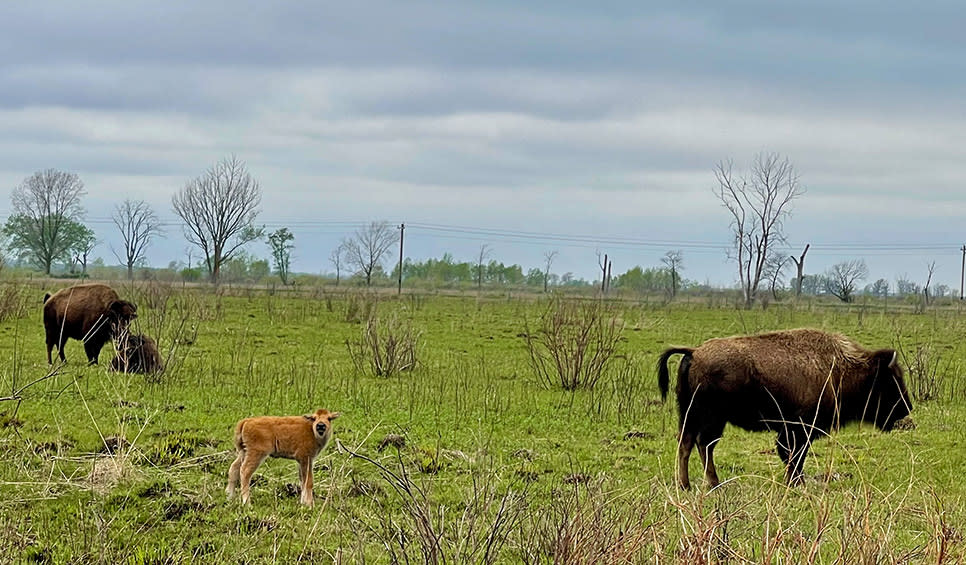It’s that exciting time of the year when the bison calves are born! At the close of 2020, we had 93 bison in our in our Kankakee Sands herd. As I pen this article, twenty-one calves have already been documented in the bison pasture, which means that for the first time in the history of Kankakee Sands, we have more than 100 bison grazing on our prairies!
With 32 mature cows in our herd, we are expecting somewhere between twenty-five to thirty calves to be born this spring. Cows typically give birth to one calf per year; twins are rare.

Bison calves, with their red fur and sprightly 40-pound bodies, are a joy to watch romp on the prairie. These energetic little ‘red dogs’ are able to run when they are just hours old. And run they do! While the female bison calmly graze and chew their cud, the calves are often seen sprinting around the matriarchal groups in wide circles, only to stop suddenly and decide that it is time to nurse.
As the year progresses, the calves will run less and eat more; their fur will change from red to brown, and they will begin a steady ascent to their ultimate adult weight of weight of 1200 lbs. for a female and 2000 lbs. for a male.
There’s such a natural comfort in watching the calves grow up on the prairie. It seems so ‘right’ to have them here that it is sometimes hard for me to remember is that just five years ago, there were no bison at Kankakee Sands, not even one.
It was in October of 2016 that we first brought twenty-three bison to Kankakee Sands to help manage our prairies. These keystone species of the North American prairies create habitat for insects, birds, mammals, reptiles and amphibians as their massive bodies move across the prairie, churning up soil, eating vegetation, defecating and reproducing.
Our Kankakee Sands’ bison program is part of a larger initiative of The Nature Conservancy (TNC) in North America to return bison to the prairie landscape. Thirteen bison herds totally 5,800 bison are owned and managed by TNC, at such properties as Nachusa Grasslands in Illinois, Dunn Ranch in Missouri, Broken Kettle Grasslands in Iowa and the Tallgrass Prairie National Preserve in Kansas.
Can you imagine that in pre-settlement times, there were an estimated 30 to 60 million bison roaming North America?! These massive one-ton herbivores grazed the landscape from Canada to Mexico, New York to California.
A mere 300 years later, at the end of the 19th century, nearly all of the bison in North America were gone. Only 325 bison existed on earth. In our state of Indiana, the last wild bison was killed in southern Indiana, near French Lick, in 1830.
The decimation of the North American bison was not just the result of habitat loss as European settlement expanded westward. The extermination of the North American bison was an intentional effort supported by the United States Army and white settlers to put hardship on Plains Nations, so that Indigenous peoples would be forced onto reservations. Bison were not only an important source of food and materials for Indigenous Peoples in North America, but also culturally and spiritually significant. The Army recognized that with bison gone, the plains tribes could be subdued, and their populations reduced.
Since those dark days, many private citizens and conservation organizations around North America have been working together to bring bison back to the landscape. Thanks to the efforts of many including, but not limited to Samuel Walking Coyote, Fred DuPree, Charles Goodnight, The American Bison Society, National Park Service, zoos, Native American tribes and Canadian First Nations, Canadian and Mexican wildlife management agencies, state wildlife management agencies, academic institutions, and non-governmental organizations, bison now number around 350,000. TNC is proud to be part of this effort and work in partnership with others.
Come celebrate 100 bison with us this spring! Visit the Bison Viewing Area at Kankakee Sands, open from 7 am to dusk every day of the year, and share the excitement. Hoorah!
We would like to extend a very special thank you to the Natural Resource Conservation Service for permission to graze bison at Kankakee Sands on acres enrolled in the Wetland Reserve Easement program.
The Nature Conservancy’s Kankakee Sands is an 8,300-acre prairie and savanna habitat in Northwest Indiana, open every day of the year for public enjoyment. For more information about Kankakee Sands, visit www.nature.org/KankakeeSands or call the office at 219-285-2184.
More Nature Notes
Nature Notes: Bison, by the Numbers, at Kankakee Sands
- 4 min read
It’s that exciting time of the year when the bison calves are born! At the close of 2020, we had 93…
Nature Notes: Hoary Vervain at Kankakee Sands
- 3 min read
A Crowd Pleaser I overlook things all the time – but insects don’t. I walk, bike and drive…
Nature Notes: Chatty Little Grasshopper Sparrows at Kankakee Sands
- 4 min read
Header photo by Kathy Malone Nature isn’t always what it seems – a chatty little…
Nature Notes: The Smell of Spring - Skunk Cabbage at Kankakee Sands
- 3 min read
After a long gray Indiana winter, it’s a real joy to smell skunk cabbage (Symplocarpus foetidus), one…
Nature Notes: Growing the Fancy Plants at Kankakee Sands
- 5 min read
Trudging through the cold north winds on an early March morning, icy rains slashing my face, I make my way…
Nature Notes: I Love Winter at Kankakee Sands
- 3 min read
Photo by Jessica Gomez TNC With its short days, grey skies and cold temperatures, February in Indiana can…
Nature Notes: Crossing Those Lines - Migrating Monarchs
- 3 min read
Photos by Trevor Edmonson This past September, upwards of 2,000 monarchs congregated on the oak trees growing…
Nature Notes: Grounded - Leopard Frogs at Kankakee Sands
- 4 min read
Northern leopard frogs are fast, real fast! They aren’t called leopard frogs for nothin’. They…
Nature Notes: One Bat, Two Bat at Kankakee Sands
- 3 min read
This spring we were delighted to look up and find that our furry, winged, big brown bat mascot was hanging…
Nature Notes: Royal Confusion - Butterflies at Kankakee Sands
- 5 min read
Header photo: Viceroy Butterfly by Ryan Rasmussen/TNC In early September, our Kankakee Sand prairies are…













